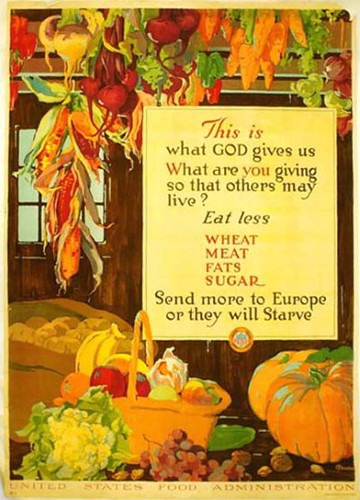As part of the ongoing exhibit of posters in Special Collections for Veterans Day, the students who created the exhibits also created entries for this blog. We will be posting these over the rest of the month of November.
1992.004.5.12 This is what God gives us. What are you giving so that others may live?….Send more to Europe of they will Starve.
This is What God Gives Us (fig. 1) is a World War I propaganda poster designed by Albert Hendee and printed by Edwards and Deutsch Litho Co. of Chicago for the United States Food Administration in 1917. The United States Food Administration was established August 10, 1917 but abolished by August 21, 1920. During its years of operation, it produced 260 posters that were used by the Education Division in the U.S. and French Liberty Loan drives, Red Cross drives, war work and enlistment campaigns, and campaigns to encourage food conservation and production (Matchette). The US Food Administration launched a nationwide campaign directed towards American families with an emphasis on women to self-ration and raised awareness about what could be done at home to help the Allied Soldiers. This is What God Gives Us conveys a sense of home and comfort through a rich color palette and vibrant bountiful composition. The message written on this poster implores viewers to be mindful of consuming too many scarce ingredients while the depiction of an abundance of food provides a feeling of security implying that the land is fertile and with the help and home gardens, everyone will be fed. The use of God is a secondary element that adds a slightly more forceful incentive. It reminds the viewer that God has given, the troops have given, and asks what have you given.
One publication is available in which This is What God Gives Us is printed, Wake Up, America. World War I and the American Poster by Walton H. Rawls. It is also mentioned in detail in an illustrated catalogue compiled by Elizabeth Sudduth entitled, The Joseph M. Bruccoli Great War Collection at the University of South Carolina and many libraries and museums hold copies and the ability to reproduce the poster including:
Brandeis University Library and Technology Services
Brown University Libraries
Indiana State Museum Center for Science and Culture
Library of Congress
Museum of the City of New York
Museum of New Zealand Te Papa Tongarewa
Northern Illinois University Libraries
Online Archive of California
University of Minnesota Libraries
University of South Carolina Libraries
University of Tulsa Special Collections
Washington State University Libraries
The Library of Congress has a version of This is What God Gives Us that varies only in its written message; Eat less, and let us be thankful that we have enough to share with those who fight for freedom was produced one year later, in 1918 (fig. 2). The United States Food Administration posters are generally colorful and aesthetically optimistic. They include the viewer in the war effort by comparing food to ammunition as seen in Food is Ammunition – Don’t Waste It (fig. 3) and suggesting ways for all members of the family to contribute from home as in The spirit of ’18–The world cry, food–Keep the home garden going (fig. 4) and US School Garden – Raised ’em Myself (fig. 5).
Bibliography
1. Brandeis University Library and Technology Services. Accessed October 2, 2012. http://lts.brandeis.edu/
2. Brown Univeristy Library. Accessed October 2, 2012. http://library.brown.edu/
3. Imperial War Museums. Accessed October 2, 2012. http://www.iwm.org.uk/collections/item/object/27951
4. Indiana State Museum Center for Science and Culture. Accessed October 2, 2012.
www.indianamuseum.org/museumcollections
5. Library of Congress. Accessed October 2, 2012. http://www.loc.gov/index.html
6. Matchette, Robert B. Guide to Federal Records in the National Archives of the United States. Accessed October 2, 2012. http://www.archives.gov/research/guide-fed-records/groups/004.html.
7. Museum of New Zealand Te Papa Tongarewa. Accessed October 2, 2012. http://www.tepapa.govt.nz/pages/default.aspx
8. Northern Illinois University Libraries. Accessed October 2, 2012. http://www.ulib.niu.edu/rarebooks/specoll.cfm
9. Online Archive of California. Accessed October 2, 2012. http://www.oac.cdlib.org/
10. Palmer, Daniel S. “S.O.S. Means Save on Sugar” – The Campaign Against Sugar in the U.S. Last modified October 7, 2010. http://www.rockwell-center.org/exploring-illustration/%E2%80%9Cs-o-s-means-save-on-sugar%E2%80%9D-%E2%80%93-the-campaign-against-sugar-in-the-u-s/.
11.Sudduth, Elizabeth, ed. The Joseph M. Bruccoli Great War Collection at the Unversity of South Carolina: An Illustrated Catalog. Columbia, SC: University of South Carolina, 2005.
12. University of Minnesota Libraries. Accessed October 2, 2012. http://umedia.lib.umn.edu/node/44655
13. University of South Carolina Libraries. Accessed October 2, 2012. http://library.sc.edu/
14. University of Tulsa Special Collections. Accessed October 2, 2012. http://www.utulsa.edu/libraries/mcfarlin/special-collections.aspx
15. Rawls, Walton H. Wake up, America. World War I and the American Poster. New York: Abbeville Press, 1988.
16. Washington State University Libraries. Accessed October 2, 2012. http://www.wsulibs.wsu.edu/
— Guest post by Elizabeth Klumpp


